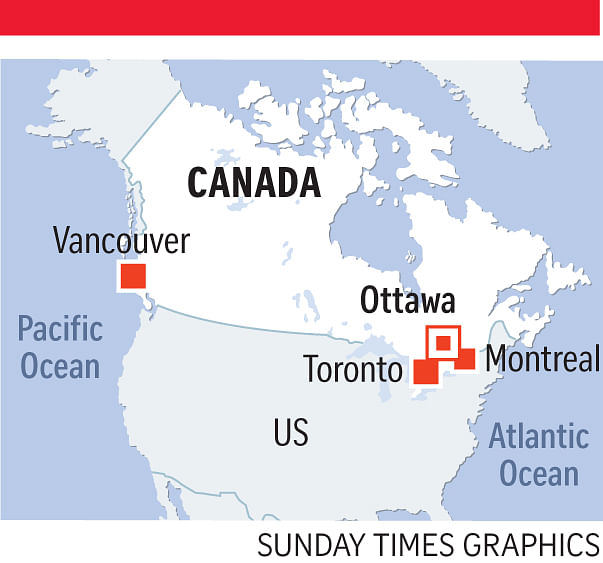-
Getting there
There are multiple Singapore Airlines (www.singaporeair.com) flights to Shanghai's Pudong International Airport, where travellers can connect with Air Canada's (www.aircanada.com) new daily flights between Shanghai and Montreal on the Boeing 787 Dreamliner. Total flying time to Montreal is just over 22 hours.
Emirates' (www.emirates.com) Airbus from Singapore to Toronto via Dubai is a few hours longer. Once in Toronto, there are quick multiple flights to Montreal on Air Canada or WestJet (www.westjet.com).
Getting around
Central Montreal is, for the most part, quite walkable and bikeable, unless it is winter. Even then, there are plenty of excellent options.
• Bicycle: Bixi, Montreal's bike sharing system, runs from April to November. Go to bixi.com/en
• Boat: You cannot get around the whole city, but you will see some sites from the Saint Lawrence River. Go to www.bateaumouche.ca/en
• Metro: The website has maps, fees and even a description of the art in each station. Go to www.metrodemontreal.com
|
• Tour bus: Gray Line's hop-on, hop-off double-decker bus does a central Montreal loop of the city's most visited areas. Go to bit.ly/2ohzlSE
• Taxi: Montreal, it is said, has too many taxis. It is easy to hail one on the street. There is even a new all-electric taxi company, Teo, with an app. Go to teomtl.com/en
Cirque du Montreal
The city is a mix of the old-school and the eccentric, and where revellers party late into the night
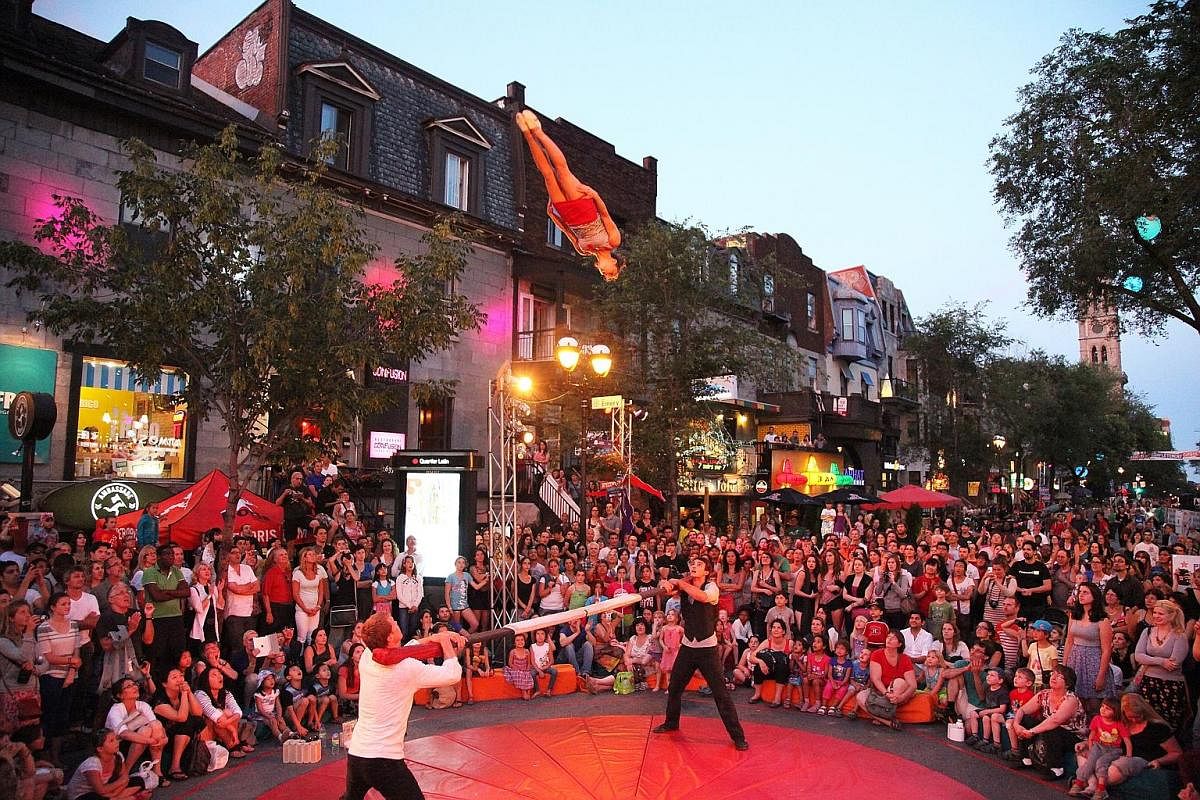
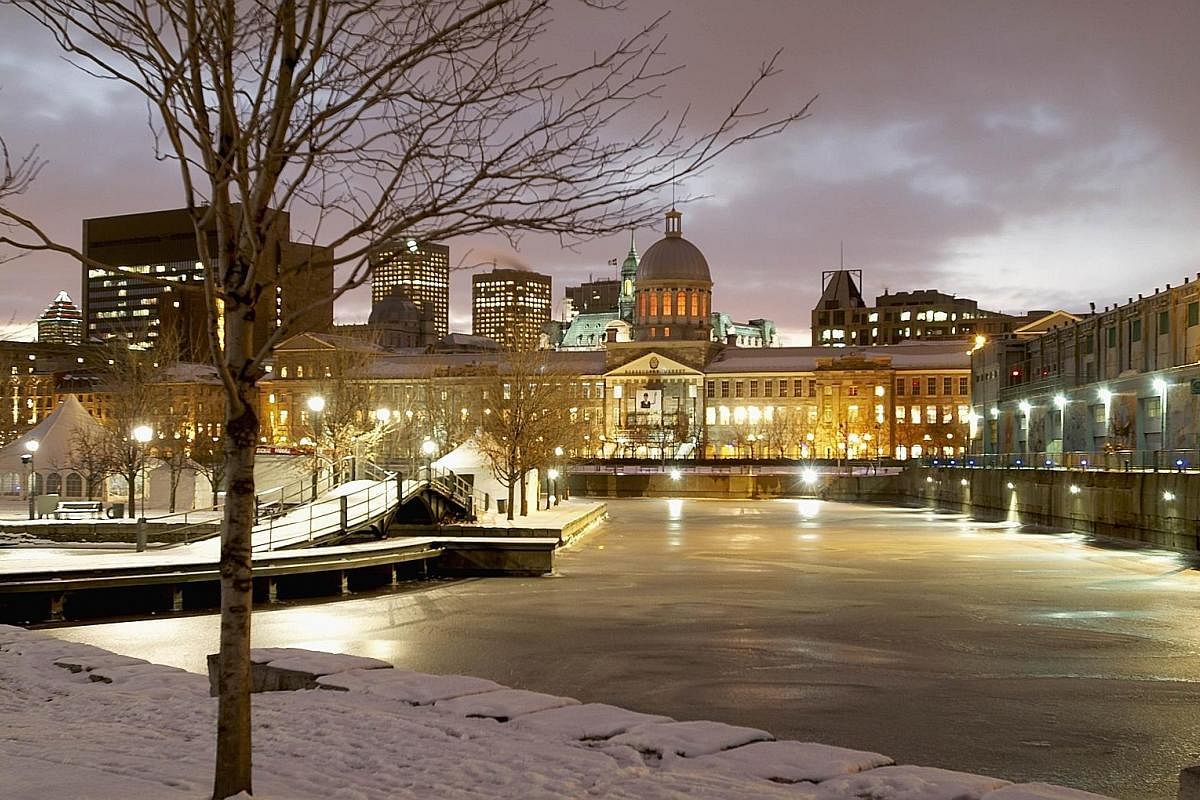

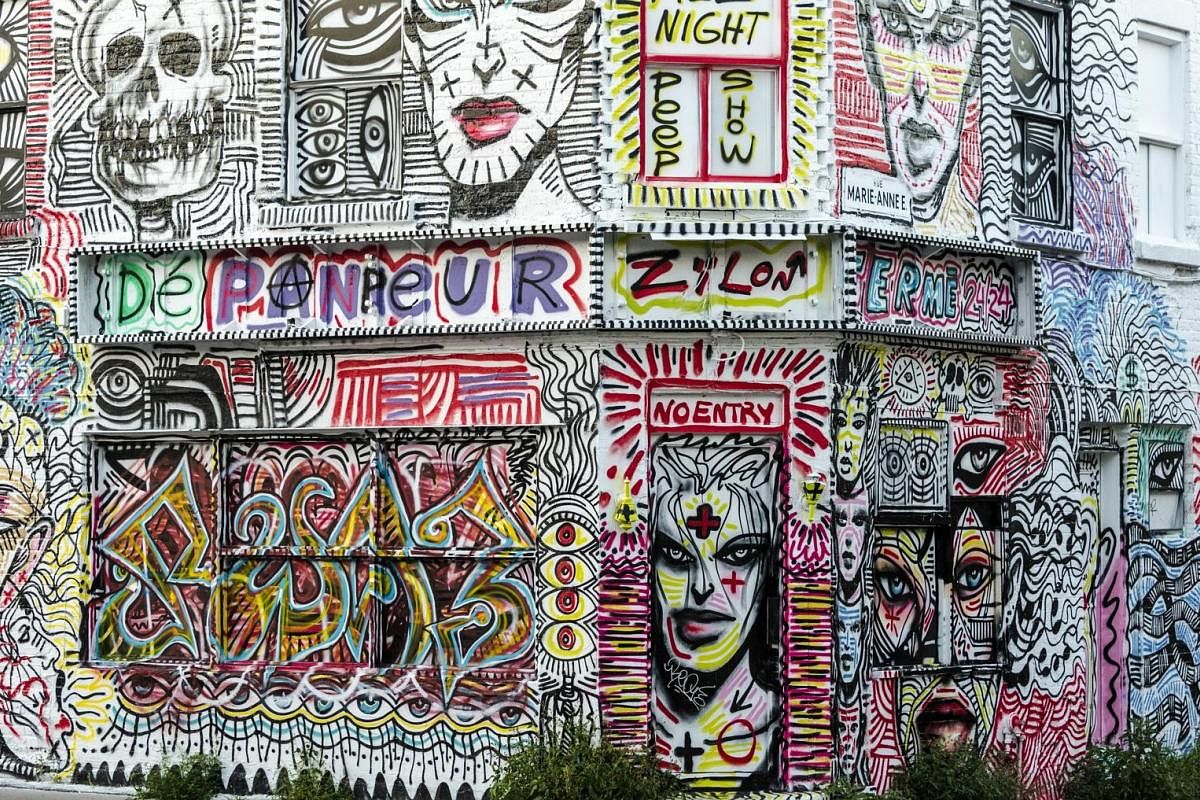
My adopted city, Montreal, is almost daunting to describe because it is just so odd. It is a French-speaking Canadian city in an Englishspeaking continent. Its population eschews grandiose financial success yet splurges endlessly in its 6,000 restaurants. And its most well-known industries sell fantasy.
Some cities export auto parts, others pharmaceuticals; Montreal exports jugglers, acrobats and technological wizardry. Cirque du Soleil and a dozen small circuses were born here and aspiring performers flock to Montreal's National Circus School. Digital games and special effects studios abound. Remember those aliens in the science-fiction movie Arrival (2016)?
But most of all, Montreal loves to party and play, no matter the weather.
I muse on such things when I am out running in the snow and it's -20 deg C. Here, winter lies in the collective unconscious. "Mon pays ce n'est pas un pays, c'est l'hiver," sings Quebecer Gilles Vigneault. "My country isn't a country, it's winter."
Winter or summer, you'll see Montreal's joie de vivre on display, especially this year at its 375th birthday celebrations.
For revelry and history, start at Vieux-Montreal (Old Montreal), the city's 17th-century birthplace on the edge of the Saint Lawrence River. This once ultra-Catholic enclave settled by fur traders and priests has no shortage of old churches (including one displaying a saint's heart in a reliquary), but Notre-Dame Basilica (www.basiliquenotredame.ca/en) is the marquee attraction.
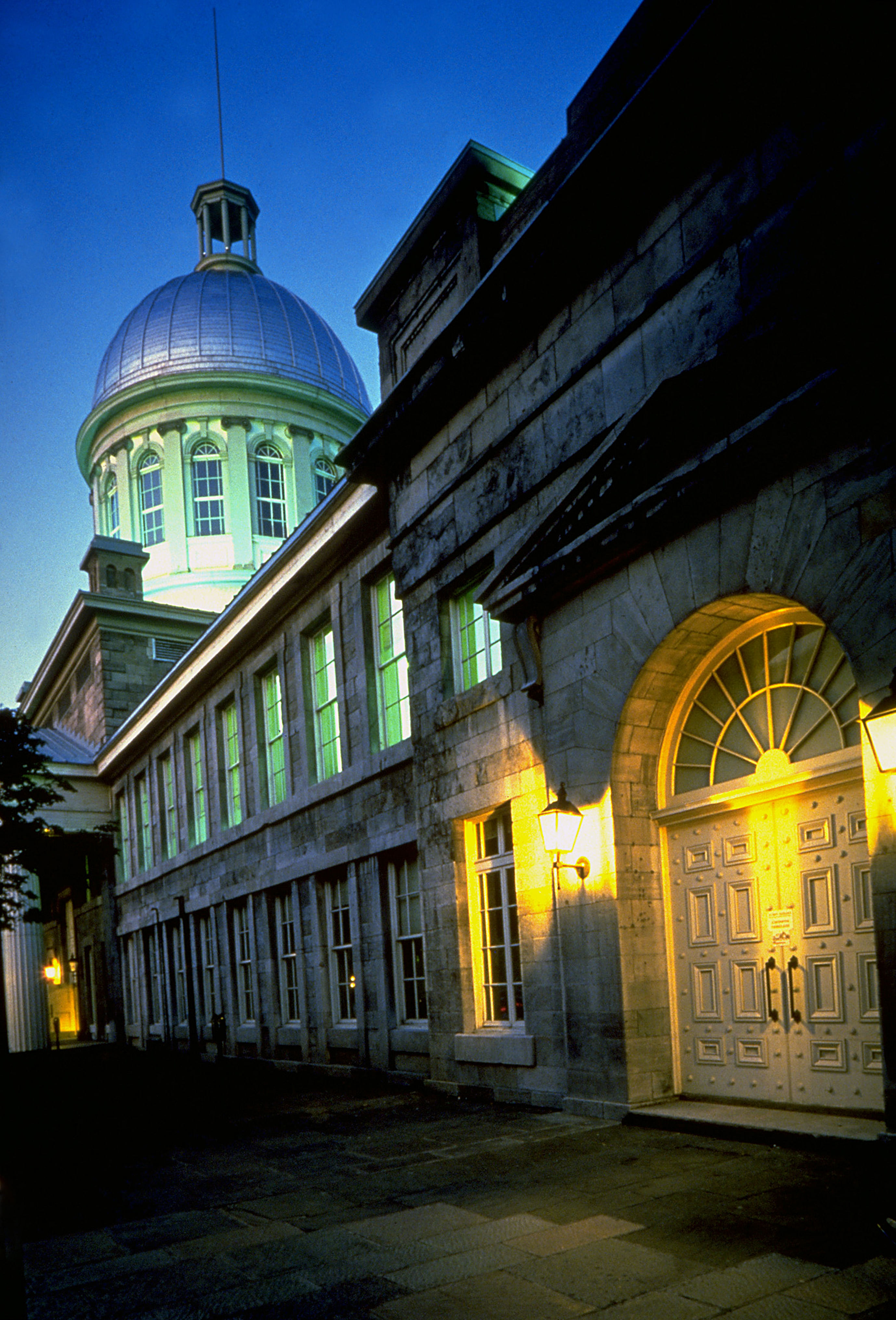
Sure, it has an 11-tonne bell and Gothic Revival vaulted ceilings, but for selfie-taking fans outside, it is truly famous as the church where Montreal's chanteuse, Celine Dion, was married.
Lesser known is Montreal's first stone chapel, Notre-Dame-de-BonSecours (margueritebourgeoys.org). Climb its steep, narrow steps to the bell tower for the best view of the river and old city. Underneath the chapel, see 2,400-year-old artefacts from when the place was a Native campsite.
Old Montreal has contemporary Native art too. Stop at Galerie Images Boreales (www.imagesboreales.com) to see serpentine stone and whalebone sculptures from Ojibway artist Paul Bruneau and Inuit artist Lukie Airut.
Along the narrow cobblestone streets you will find tiny shops featuring local, independent fashion designers. Montrealers, often a quirkily attired bunch, seem to prefer their own clothiers to Chanel or Dior, explains fashion maven Emanuela Lolli.
"People here go for an androgynous look,'' she tells me. And their unique winter style? She describes that as nordicite. "Very warm fabrics in a palette of black and dark grays."
From my standpoint, black clothes are not just chic, but also sensible. You would be easier to spot should you slip and disappear into a snow bank while in a dancing frenzy at Igloo Fest (igloofest.ca), Montreal's icy outdoor electronic music party.
But if dancing in boots and mittens is not for you, rent ice skates at the public skating rink or watch 17th-century-style ice canoe racing on the frozen river, another wacky winter activity.
Probably the best place to watch canoes on a frozen river (or paddleboats in warmer seasons) is from the unusual floating spa, Bota Bota (botabota.ca/en). This spa on a docked ferryboat is where you can have panoramic views of the city and river while steaming and preening on its deck.
Follow one indulgence with another and have lunch at neighbourhood favourite Les 400 Coups (www.les400coups.ca/en). The talented young chef serves up Quebec terroir cuisine such as bison collar with winter carrots and black apple puree.
A TASTE OF THE QUIRKY
In Old Montreal, there are plenty of transport options. Bixis are graband-go bicycles at stands around the city. Ride all day for five Canadian dollars (S$5.20) and drop it off at another Bixi location.
But Montreal's most famous transport is its Metro. Each of its 68 stations is designed by a different architect and many feature the art of well-known Montrealers.
If you ride the Metro (www.metrodemontreal.com) from Old Montreal to the Place des Arts complex of arts spaces, you will see one of the subway's most vaunted artworks, Frederic Back's music-themed stained glass mural. It is a perfect introduction to your next district, Quartier des Spectacles (www.quartierdesspectacles.com/en), the entertainment neighbourhood.
This 1 sq km of downtown Montreal has more than 80 galleries and performance spaces, where you might see anything from a poetry slam to a symphony.
Nights in the area are especially interesting because this dark, cold northern city takes the art of light seriously. Even the city's major bridge is being permanently outfitted with several thousand lights which will change colour and rhythm with the weather and traffic.
Quartier des Spectacles is a bit like Singapore's i Light Marina Bay festival, but on steroids. Buildings are illuminated in all seasons and the area is home to festivals of light, film, theatre, comedy, circus, dance and music.
In Montreal, restaurants abound, from the offbeat mom-and-pop style to the celebrity chef genre.
Zebulon Perron, Montreal's restaurant design darling, tries to explain this overabundance of eateries.
"There's this thing we love about being in public, hanging out," he says over coffee. The chefs and food can be the highest quality, but "we don't go for gilded places. Everything is casual and often pretty quirky".
Take, for example, his latest design, Montreal Plaza (montrealplaza.com/en). There, well-known chef Charles-Antoine Crete holds court in an establishment with an in-restaurant greenhouse, a small stop-motion studio and random objects such as a spinning upsidedown dollhouse hanging from the ceiling. "The chef is brilliant and the restaurant is a canvas for his nuttiness," Perron says, laughing.
From Quartier des Spectacles, it is an easy walk to Sherbrooke Street, some of the more established galleries and the splendid Montreal Museum of Fine Arts (www.mbam.qc.ca/en). Do not, however, miss the under-the-radar Redpath Museum (www.mcgill.ca/redpath/redpath-museum) for a look at weird stones, bones and remnants of plesiosaurs and ichthyosaurs.
Sherbrooke Street, once called the Golden Mile, was the exclusive turf of the 19th-century 1 per cent and is still lined with period buildings. One of those, Ritz-Carlton Montreal (www.ritzcarlton.com/Montreal), is a perfect place to set up camp. Not just for the luxury, but for its history too.
Housed in a Neo-Classical palazzo style building, the majestic hotel opened in 1912. Its recent renovation preserved much of its classic glamour, so a visit is a chance to time-travel to an elegant period of Montreal's history.
From here, it is easy to make your way to even more eccentric districts.
Le Village, close to downtown, is where you will find Montreal's weird version of pub darts at Rage (www.ragemontreal.com/en), an axethrowing venue, a uniquely Quebec woodsman-style pastime.
Urban explorers might venture east to Hochelaga-Maisonneuve for the Insectarium (espacepourlavie.ca/en/insectarium), North America's largest collection of creepy crawlies. A most curious neighbourhood within a neighbourhood (St Michel) is Cite des Arts du Cirque. This Circus City complex is the headquarters of Cirque du Soleil, Ecole nationale de cirque (The National Circus School) and Tohu (tohu.ca/en), Montreal's circus arts performance centre. At Tohu, there is almost always some sort of performance in this circus-happy district.
A love of performance and spectacle permeates the city in ad hoc ways too. There are musicians in the Metro, and on street corners and in parks there are colourfully painted public pianos for musical passers-by.
In warm weather, there is the city's most delightfully chaotic event, the Tam-Tams. It is a weekly outdoor drumming party in Parc du Mont-Royal. The impromptu gathering, which began about 30 years ago, attracts percussionists and Montrealers who just want to dance.
You will see everything from twirly, eyes-closed hippie dancing to expert execution of African dances. And do not be surprised if costumed warriors and knights with foam swords run by you chasing one another. These fans of live action role play are regulars, just up the hill from the drummers.
ARTISTIC, ODDBALL MILE END
Mount Royal borders Mile End, my neighbourhood. It is the city's most artistic and oddball district. Since the 19th and 20th centuries, waves of refugees and immigrants, including Italians, Greeks, Portuguese and Eastern European Jews, came to the area to work in the textile factories.
Hippies, musicians and artists followed in the 1960s and 1970s. They shared the area with the workingclass communities filling the old Italian cafes and shopping in small grocery stores. This multi-ethnic neighbourhood's soundtrack is still a melange of languages including a most colourful one, Franglais (like Singlish).
Although a recent wave of gentrification and hipster-isation has made my home turf "trendy", there are a lot of the old places to visit still - and artists, musicians and joyously flaky and serious performers of all kinds to meet in the old- school cafes.
Hipster-style shops and restaurants are starting to crowd out locals, but Mile End is still the place for hole-in-the-wall classics. Ignore the Ben Folds eyeglass emporiums and cold-pressed juices bars. Visit the long-time family-owned places our family goes to.
Duck into Delphi (221 Avenue Fairmount Ouest), a Greek depanneur, or Montreal's version of a mom-and-pop shop, owned by the Tsoudis family for nearly a half century. Besides daily-life sundries, you can pick up olive oil and dried camomile flowers from the owner's family fields in Crete.
At three-decades-old S.W.Welch bookstore (bit.ly/2oWkq1r), lounge as long as you want - even late at night - in saggy couches, among stacks and shelves of used and rare tomes.
Wander Mile End and you will see commando art projects everywhere. Scrap metal artist Glen LeMesurier borrows neighbours' front yards to display his sculptures, random bits of poetry are taped on fences and trees are sometimes decorated with yarn and found objects.
Try perogies, starchy delicious potato dumplings, at cosy Euro-Deli Batory (www.eurodelibatory.ca), a Polish mom-and-pop restaurant next to a domed church inspired by Istanbul's Hagia Sofia.
Do not miss authentic Roman pizza taglio at the tiny five-table Carboni (www.carbonicafe.ca) where, says co-owner Claudia Marchese, the pizza dough is made from 130-year-old sourdough starter brought from Italy.
And, of course, do not leave without dropping into St Viateur Bagel (www.stviateurbagel.com) to watch Montreal's premier performance: bagel-making. Since 1957, the bakers have kneaded, stretched and twirled dough into rings, and baked them into bagels on an open wood fire. The steamy old-world shop is visited as much for the bagelmaking performance as for the chewy sweet bagels.
Mile End's two old favourite cafes, Club Social (www.facebook.com/cafeclubsocial) and Olimpico (www.cafeolimpico.com), both run by Italian families, have deep roots in the neighbourhood. Over a cappuccino, you will discover what really drives this city: long, lounging relaxed conversation. Montreal slang for this small talk is jaser.
I have lived in Montreal on and off for a few decades and early on, a friend had explained the slower pace, long lunches and gabbing in cafes in this way: "In France, it's 'discuter'. They discuss. Here, we chat and chat. It's like jazz."
When night falls, conversation continues over drinks and snacks at hangouts such as La Buvette Chez Simone (buvettechezsimone.com), presided over by actress-owner Simone Chevalot. Although young celebrities such as Cannes Festival favourite Xavier Dolan often show up, the atmosphere is unpretentious.
Later - this is a late-night town - it is time to hear live music.
Fans of indie bands head to charmingly scruffy favourite clubs such as La Sala Rossa (lasalarossa.com) and Casa del Popolo (casadelpopolo.com/en), where many well known hometown indie artists such as Arcade Fire, Patrick Watson and Socalled have played.
Though, sadly, some of my favourite haunts have disappeared, sometimes, on my pre-dawn runs through the neighbourhood, I hear singing, laughter and the crunch of snow under boots.
At that moment, I am joyfully reassured that this city is still delightfully unpredictable, eccentric and will always have its all-night young revellers happily making their way home just before dawn.
Et Voila.
• Judith Ritter is an American freelance journalist living the bohemian life in her adopted city, Montreal.
Join ST's Telegram channel and get the latest breaking news delivered to you.
A version of this article appeared in the print edition of The Sunday Times on April 16, 2017, with the headline Cirque du Montreal. Subscribe
